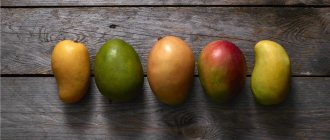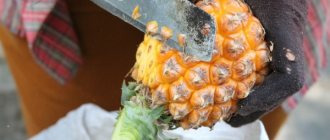Features of Green Mango
Mango fruits come in a variety of varieties, so there are ripe fruits that are green on top.
Useful properties of the fruit:
- prevention of colds due to the presence of a large amount of vitamin C;
- improved vision is ensured by the presence of vitamin A;
- normalization of the nervous system due to the presence of vitamin B6;
- stabilization of the digestive system;
- removing toxins and waste from the body;
- lowering cholesterol and blood sugar levels, so the fruit can be consumed for diabetes and for weight loss;
- prevention of the development of cardiovascular diseases due to the maximum potassium content;
- positive effect on bone tissue and rapid healing of skin lesions;
- prevention of the development of oncological processes in the body;
- acceleration of metabolism, removal of excess fluid from the body.
The calorie content of green mango per 100 grams of product is only 67 calories.
Before directly consuming the fruit, it is important to consider some contraindications for its use:
- use for children under 3 years of age;
- avoiding alcohol consumption in combination with mangoes;
- predisposition to allergies;
- increased sensitivity of mucous membranes.
Vitamin and chemical composition, calorie content, nutritional value, glycemic index
Mango at home What vitamins are in mango and what are the benefits of the fruit? Many substances in mango are irreplaceable. The pulp includes vitamins A, C, group B, E, PP.
Minerals include potassium and magnesium, calcium, phosphorus, sodium, zinc, iron, copper, manganese, selenium. The composition contains starch, flavonoids, polyphenols, organic acids and sugars.
There are differences between the composition of ripe and unripe fruits. Unripe ones contain more starch, organic acids and pectin.
In 100 g of pulp - 82 grams of water, 0.5 g of protein, 0.4 g of fat, 14.9 g. carbohydrates. There is ash and fiber.
Calorie content 1 pc. fresh mango (energy value) - 63-70 kcal per 100 g of fruit. Nectar has fewer calories - about 40 per 100 g. Mango is a food with a medium glycemic index.
The program “About the Most Important Thing” will tell you about the benefits, harms and contraindications of mango fruit for the body:
Storing ripe fruit
It is advisable not to store fresh mangoes for a long time, but to eat them immediately. This way you will feel the maximum taste and tropical pleasure.
Signs of a ripe mango
As mentioned above, several parameters are responsible for the ripeness of a mango:
- The mango should have a glossy, dense and elastic surface without damage.
- The smell should be distinct, but not strong.
- The shape of the mango must be round, otherwise the fruit is not ripe.
Storing cut mango
The cut fruit has a very short shelf life. The pulp turns black, hardens and loses its taste. It is recommended to store this way only in an airtight container, and no more than a day.
Optimal storage conditions
If there is a need to preserve the fruit longer, then there are several options on how to do this. Mangoes can be stored indoors, in a cool, dark place, in the refrigerator and freezer.
- Mango should be stored at room temperature for no more than 5 days, after which it begins to turn black, the flesh becomes soft, and the taste becomes soapy.
- In a cool, dark place, the freshness of the mango will increase, but not much. The number of days depends proportionally on the ripeness of the fruit. The riper it is, the faster it will spoil.
- Storage in the refrigerator is optimal. On the middle shelf of the refrigerator, wrapped in paper or in a container, mangoes will keep for more than 10 days. The temperature should not be lower than +3-+5 degrees.
- In the freezer, mangoes amazingly retain all their flavor and aroma, so this is the best option for long-term storage. The freezer temperature should be from -24 to -18 degrees, so mangoes can be stored for more than 3 months.
Determining the degree of ripeness and proper storage
In order not to later wonder how to make a mango ripe, it is better to be able to determine the degree of ripeness of the fruit even when purchasing . It is not difficult:
- The ripe fruit exudes a bright, sweetish-resinous, fruity odor , especially in the area of the stalk.
- When pressed, the flesh springs slightly , like a ripe peach.
- The skin of the ripe fruit is shiny, smooth and dense , the color varies from yellow to red-orange depending on the variety. There are varieties of green mango with orange flesh, but they are extremely rare on our shelves.
- Dark spots on the surface of the fruit do not always indicate that the product has begun to deteriorate . The fruit probably contains a lot of sucrose. However, if the spots are soft and can be easily pressed with a fingernail, it is better not to buy the fruit.
- The most delicious and aromatic fruits have a spherical shape.
The ripe fruit smells of both pineapple and peach with a light trail of pine needles . Connoisseurs of this exotic fruit are sure that the strong aroma indicates one hundred percent ripeness.
Storage rules:
- Do not put green fruits in the refrigerator - the ripening process in such conditions will slow down and the product will spoil. Keep ripe and overripe fruits in the crisper drawer in the refrigerator compartment.
- The shelf life of ripe fruit in the refrigerator is 5-6 days at a temperature of +2...+5°C, in the freezer - six months at –18°C. When frozen, the product retains its taste.
- Cut fruit quickly deteriorates, the flesh darkens and loses its taste . Store this product in a food container with an airtight lid for no more than 24 hours.
- Unripe mangoes can be stored for up to 7 weeks at a temperature of +7...+9°C and air humidity of 90%.
How to peel a mango
Should mangoes be peeled before eating? Before eating the fruit, remove the skin and seeds, after which it is suitable for consumption.
How to remove a pit
There are several methods for removing seeds from fruit:
- First way. To do this, the product is placed on a cutting board and secured by hand. There should be a part with a tail on top. After this, you need to draw a knife along barely visible lines that go from top to bottom. This is done on each side. Thanks to this technique, it will be possible to facilitate the process of removing the stone and minimize the risk of damage to the fetus. The pit is easily removed with a spoon.
- Second way. In this case, the fruit will remain almost intact. Using a sharp knife, cut the fruit lengthwise. Moreover, the size of the hole should be small - no larger than the core. Place a knife into the resulting slot and carefully turn it so that the halves move apart. Then take out the bone with a spoon. This method will give good results if the mango is ripe enough.
- Third way. In this case, you can cut through the entire fruit so that the hole is along the flat part of the stone. To do this, use a sharp knife. The core is removed with a spoon.
How to peel
To peel a mango, use the following methods:
- Kitchen knife. In this case, the fruit is peeled like potatoes. To do this, cut off the thin peel. You can make 2 cuts. They are made on the other side of the ponytail. After that, it is recommended to stretch the skin with your fingers to the second end.
- Vegetable peeler. This method will take more time. However, the skin will be cut thinly and neatly.
- Without using a knife. This method can only be used for ripe fruit that has been cut into 2 parts. To do this, arm yourself with a glass. Take half the fruit in one hand and the glass in the other. Place the mango, peel side up, and gently press onto the glass. The size of the glass should be slightly smaller than the fruit. Due to this, the pulp will fall into the glass, and the skin will remain in your hand.
Application in cosmetology
Mango is a source of vitamins (A, B, C, E, K), minerals (potassium, phosphorus, calcium, magnesium), saturated fatty acids (oleic, stearic, palmitic, arachidic, linoleic), which are essential for maintaining youthful and beautiful skin , hair Thanks to its balanced composition, the fruit protects the dermis from the aggressive effects of low temperatures, wind, and ultraviolet radiation.
Asian apple extract or oil:
- moisturizes, nourishes, refreshes the skin;
- normalizes metabolic processes in tissues;
- relieves itching;
- eliminates irritation, dryness, peeling;
- fights pigmentation;
- restores the lipid barrier;
- prevents the appearance of stretch marks;
- softens rough areas;
- smoothes hair fiber scales;
- neutralizes the effects of free radicals;
- promotes moisture retention after sun treatments;
- evens out facial tone;
- returns softness, firmness, elasticity to the dermis;
- protects cell membranes from premature destruction;
- promotes skin regeneration;
- accelerates the healing of microtraumas, wounds, cracks.
The secret of a tropical fruit mask
The vitamins, macro- and microelements that make up mango nourish the dermis and solve the following issues:
- ascorbic acid – rejuvenates;
- retinol – relieves inflammation, moisturizes;
- choline – calms;
- folic acid – protects against harmful effects;
- tocopherol – tones, fights acne, acne.
Mango mask is beneficial for the following skin types:
- oily (regulates the functioning of the sebaceous glands);
- dry (moisturizes);
- sensitive (forms a protective shell);
- fading (smoothes out wrinkles);
- problematic (relieves inflammation).
In order for the beneficial properties of mango to be fully manifested, use only soft, juicy, ripe fruits. Remember, the tropical fruit contains active, aggressive substances and acids, so before applying the mask to your face, check it for allergies. To do this, spread the mixture evenly onto the skin of the wrist and wait 15 minutes. If there is no redness, rash, burning or itching, the mask can be applied to the face.
The duration of stay of the product on the skin is 20 minutes. If the time limit is increased, the mango mask may cause an allergic reaction or lead to acid burns. To deeply nourish the dermis, it is recommended to perform the procedure once a week, improve the condition of problem skin or eliminate oily sheen from the T-shaped zone - two.
Mango mask recipes
- Rejuvenating. Grind the pulp of half a mango in a blender, mix the resulting puree with 15 grams of starch, 10 milliliters of olive oil. Mix the mixture thoroughly.
- Cleansing. Grind the mango until mushy. Grind almonds and oatmeal into flour. Combine all ingredients in equal quantities, add thick cream 35%, cosmetic clay.
- Nutritious. Ingredients: 30 grams of mango pulp puree, 15 milliliters of olive or peach oil, 5 milliliters of bee honey.
- Anti-inflammatory. Mix half a mango puree with 50 milliliters of medium-fat kefir.
- For dry skin. Mix the crushed pulp of half a mango with 5 milliliters of chamomile or apricot oil, 15 grams of butter, and the yolk of one chicken egg.
- For the sensitive. Grind the mango pulp into a puree and apply it to your face.
- For oily skin. Beat the white of one chicken egg and puree the pulp of half a mango. Combine these ingredients, add 5 grams of bee honey.
- From blackheads. Mix mango pulp with olive oil until the consistency of thick sour cream.
- To improve facial tone. Boil one carrot, grate 50 grams. Grind a third of the mango pulp with a fork. Combine the ingredients, add 5 milliliters of chamomile oil, 60 milliliters of pre-melted natural honey.
- From wrinkles. Steam the oatmeal. Add mango juice and natural liquid honey to the porridge.
- To remove the stratum corneum. Method for preparing the scrub: mix 5 grams of almonds ground into powder with 5 milliliters of natural honey and the pulp of a quarter of a medium mango. Bring the mixture until smooth.
- From electrified hair. Grind half a ripe mango in a blender, add 5 milliliters of kefir 2.5%, 1 chicken yolk. Distribute the resulting mixture over the entire length of pre-washed damp hair. After this, put on a plastic cap and wrap a towel over your head. After 20 minutes, rinse your hair with warm water.
Storing ripe mango
If the mango is already ripe, but you don’t want to eat it or use it for cooking, pay attention to its proper storage, which will help keep the fruit juicy and fresh longer.
There is no need to wash the fruit - this way it will be stored longer. Place the fruit in a paper bag or wrap it several times in parchment paper, and then put it on the bottom shelf of the refrigerator closer to the freezer - a lower temperature will increase shelf life. It is not recommended to leave fruit in the refrigerator door, since there it can begin to deteriorate faster due to unstable temperature conditions.
Make sure that there are no other strong-smelling foods near the mango (such as smoked fish) that it might pick up.
Check the fruit daily for softness so that it does not become too soft and crumbly, since overripe fruit can spoil in just a couple of days. Otherwise, you can store it in the refrigerator for up to 8-10 days.
We also invite you to watch a video that explains how to store mangoes:
What to do if the mango has gone bad
Even at room temperature, mangoes ripen quickly. The hardest and most unripe fruits take no more than five days to turn into a tropical delicacy. Also, this fruit, unfortunately, spoils quickly. That's why you can't keep it for long. It is also worth checking from time to time how ripe the fruit is.
But it happens that the owners realized it too late and the mango spoiled. Opinions vary as to whether unripe mangoes can be eaten. Many people believe that nothing bad will happen from this; others strongly advise throwing away the spoiled sweets. In fact, overripe mangoes are not eaten simply because there is little pleasant in such a meal - the cut delicacy acquires an unpleasant texture and sour smell, and the taste noticeably deteriorates. It is impossible to force over-seasoned fruits to become fresh again. But there are several options for where to put spoiled (but not rotten) fruits:
- Grind the fruit in a blender and make curry paste. This sauce goes well with meat, poultry, and potatoes.
- Add the fruit to the tincture.
The last option is good only for those who know the recipe exactly and are confident in it, in order to eliminate the possibility of poisoning.
Storage errors
Premature spoilage of mangoes is associated with the following in storage:
- Storing ripe mangoes with other fruits. They secrete special enzymes that can only accelerate ripening and reduce the shelf life of the fruit.
- Storing unripe mangoes in the refrigerator. By stopping the ripening process, you will not increase the shelf life of the fruit. This way it will spoil without even reaching a mature state.
Storage in a plastic bag. Replace it with parchment paper to prevent the fruit from rotting.
Storing pitted. If possible, leave the kernel in the fruit so it will last longer.
By following all the rules and recommendations for mango storage, you can not only avoid its premature spoilage, but also preserve all the valuable properties present in the fruit.
Preserving unripe fruit until ripening
Unripe fruits ripen when stored in a warm place. Leave the fruit on a plate in a warm room for a period of 3 to 7 days. Ripeness is checked every day. The ripe fruit is used immediately. It is better to leave slightly unripe fruits to ripen in the kitchen and then put them in the refrigerator. When ripened in a cold place, the fruit will have a grassy and less sweet taste than when ripened in a warm place. If you need to speed up ripening, the fruit is placed in a bag with ripe apples or bananas. Ethylene released by fruits accelerates the ripening of the fruit. In case of urgent need, you can put the mango and fruit on the windowsill under the sun's rays.
On a note! The peoples who grow mangoes have interesting life hacks for quickly ripening the fruit. Indian women put fruit in a container with rice. Fruit ripening occurs much faster. Check ripeness 3-4 times a day. In Mexico, instead of rice, they use corn (hulled ripe grains).
How to distinguish a ripe mango from an unripe one
The smell of a ripe mango has a characteristic fruity aroma, while an unripe fruit does not have any odor. Alcoholic fermentation occurs in fruits that are overripe and begin to deteriorate.
The mango should be moderately soft to the touch, since a hard peel indicates that the fruit is unripe. The ripe fruit has a round, smooth surface with characteristic brown spots.
A hard and strong peel indicates that the fruit is unripe, while damage and cracks on the surface, on the contrary, indicate that the fruit is too ripe. Therefore, when choosing a ripe mango, you need to pay attention to these aspects.
Currently reading: Dried mango: benefits and features of use
What are the benefits of tropical fruit
Mango is a leader in the content of vitamins A, E, C, and is also rich in potassium and folic acid. Its low-calorie fruits can quench hunger and thirst. Beneficial properties of mango:
- Regulates blood pressure as it contains potassium, which has a beneficial effect on the circulatory system as a whole.
- Supports immunity. It has a beneficial effect on inflammatory processes and allergic reactions of the body, facilitating their course.
- Normalizes blood sugar levels. This is especially important for people with diabetes.
- Lowers cholesterol.
Methods for ripening the fetus at home
If you accidentally bought an unripe hard fruit, do not be upset. It can be matured at home. Ripening under normal conditions can take up to a week, but this process can be significantly accelerated.
In paper
If you wrap a mango in newspaper, parchment or a paper bag and leave it at room temperature overnight, there is a chance that the fruit will ripen by morning. This happens due to the fact that under such conditions the release of ethylene is accelerated, which affects the ripening process.
You don't need to wrap the mango too tightly. Air must penetrate under the layer of paper. Otherwise, a fungus may develop, triggering the rotting process.
Ripening in a paper bag.
In rice
This method is rooted in the centuries-old history of India. If you place unripe fruit in rice, ripening will occur much faster. This also happens due to the release of ethylene. It is important to ensure that the rice is fresh and dry. The ingress of moisture, even in small quantities, can lead to product spoilage.
Do not forget to check the condition of the mango every 6 hours, because... under these conditions, there is a risk of rapid overripening of the fetus.
Ripening in rice.
In a dark place
If you put the mango in a dark place, the ripening process will take place in a shorter time than in the light. A closet or drawer that is rarely used during the day is suitable for this purpose. It is important that there are no products or other substances with a strong odor inside, because the mango can absorb it.
Harvesting Rules
To keep tomatoes at home for a long time, certain rules must be followed when harvesting. Pick tomatoes from the garden regularly: at least once every 5 days at moderate air temperatures and once every 2-3 days during hot weather.
Both ripe and green specimens are plucked from the bush carefully to prevent the slightest damage. It is best to harvest the fruits in the morning before they get hot in the sun. The surface must be dry, so do not pick tomatoes immediately after rain.
A sharp drop in temperature harms the fruits and accelerates their rotting. If the temperature at night drops to +5 ℃, then it’s time to collect all the green tomatoes and transfer them to home storage. For greenhouse tomatoes, the permissible temperature limit is slightly higher and is +9 ℃.
You can learn how to store ripe tomatoes by reading this article on our website.
Before removing unripe tomatoes from the bush, you need to decide what to do next: speed up ripening or keep them green at least until winter.
To begin with, the tomatoes need to be sorted, selecting the browned specimens that will ripen faster than the rest. Tomatoes are laid separately at the stage of milky ripeness, ripening a little longer than brown ones. Completely green fruits can be preserved until winter and served fresh and tasty on the New Year's table.
The speed of ripening depends on the temperature in the room. At a temperature of +8…12 ℃, tomatoes turn red slowly, while an indicator of +18…21 ℃ significantly speeds up the process. The higher the temperature, the faster the crop will ripen, but the quality of the fruit may deteriorate as it ripens.
This is due to a sharp loss of moisture and, accordingly, the density of the fleshy vegetable. A temperature of about +20 ℃ is suitable exclusively for tomatoes of blanzhe (brown) ripeness, which will take no more than a week to ripen. They can be placed on the windowsill, where they quickly turn red without compromising their appearance or taste.
The optimal temperature for storing green tomatoes is considered to be from +13 to +15 ℃ with a humidity level of 80%.
There is an opinion that for better ripening, picked fruits must be placed in direct sunlight. This approach will not only not give the desired result, but will also speed up the spoilage of tomatoes.
It is recommended to store unripe tomatoes in a dark, dry place.
Rules for storing mangoes
Mangoes do not store well at home. It is recommended to eat the fruit within 2 days from the date of purchase. Otherwise, its taste and nutritional properties may deteriorate.
In a refrigerator
It makes sense to store only ripe fruits in the refrigerator. If the fruit is not yet fully ripe, it should be left at room temperature. It is worth considering that the plant is tropical and is accustomed to high temperatures.
Storing fruit in the refrigerator.
Cut fruit
Peeled and cut mangoes can only be kept in the refrigerator. It is better to eat it immediately, maximum during the day. After a day, the process of decay begins, which is fraught with poisoning.
Sliced fruit should be eaten during the day and kept refrigerated.
Diseases and pests of mango
How to quickly peel pumpkin seeds at home
Mangoes have no specific diseases. Signs of the disease and treatment are the same as for other indoor plants. The reason for their appearance may be errors in care or proximity to already infected plants.
Mango diseases
Powdery mildew appears due to excess humidity in the air or soil. Signs of the disease are a white coating on the leaves, thickening and deformation of the shoots.
For treatment, the plant is treated with a solution:
- Toxina-M;
- Topaz;
- Thiovit-Jeta;
- Bayleton;
Fundazola.
Treatment is carried out 3 times with an interval of 7 days. It is recommended to alternate medications.
As a preventative measure, it is recommended to spray the plant with the following solution:
Planriza;
Alirina;
Fitosporina.
Bacteriosis can occur due to infection through damage to the trunk and leaves. Another cause of the disease is excess fertilizer. Signs of bacteriosis are dark soft spots on the trunk and leaves with a strong smell of rot.
The treatment is complex and is carried out in several stages:
- Damaged areas are cut off, capturing 5-7 cm of healthy tissue.
- The cut areas are treated with a 2% solution of copper sulfate.
- Completely change the soil in the pot.
- Alirin-B and Trichodermin are added to the soil.
- The plant is sprayed with Bordeaux mixture.
- For a month, the plant is watered with a weak solution of potassium permanganate.
Anthracnose appears as brown or yellow spots on the leaves. This is a fungal disease caused by infection through damage to the leaves and trunk of the plant.
As a treatment, the affected areas are trimmed. The plant is thoroughly washed under a warm shower and transplanted into new soil. It is recommended to treat the wood with a solution:
Fitosporina;
Cuprosan;
Oxychoma;
Akrobata-MC.
Treatment is carried out 3 times with an interval of 14 days. It is recommended to alternate spraying preparations.
To prevent the disease, you can use the drugs Fitosporin-M, Gamair and Trichodermin. Many gardeners dust the soil and plant with crushed activated carbon or chalk.
Pests
The most common pests that can be found on home-grown mangoes are spider mites and thrips. Both feed on plant sap and are classified as sucking pests.
Spider mite
Thrips
The appearance of a spider mite can be suspected by the appearance of a thin web on the underside of the leaves. The appearance of thrips is indicated by sticky brown spots on the inside of the leaves and silvery marks on the outside.
To combat pests, the plant is thoroughly washed with soapy water. Areas with signs of damage are cut off. The seedling is treated with the following preparations:
- Akarin;
- Apollo;
- Kleschevitis;
- Neoron;
- Fitoverm
- Vertimek.
Spraying is carried out 3 times with an interval of 10 days.
Helpful information
Daria Vorontsova
Amateur gardener. He is interested in growing various greens at home.
During the fight against the emerging pest, the infected plant must be quarantined, moving it away from other plants. Preparations are used to treat not only the tree, but also the place where it was located.
Another common pest on indoor plants is scale insects. This small insect with a hard shell feeds on plant sap. The appearance of scale insects can be detected by characteristic brown plaques on the trunk and leaves of plants.
Thanks to its shell, the scale insect is reliably protected from external influences. Therefore, when this pest is detected, there is no point in grabbing drugs. First, insects should be removed mechanically. To do this, the plant is thoroughly wiped with a soft cloth and soapy water. After treatment, wash the seedling under a warm shower.
After most of the insects have been removed, insecticides are used. They destroy eggs and larvae of pests invisible to the eye. In addition, the preparations create a thin film on the surface of the leaf, making it inedible for pests. You can use the following against scale insects:
Aktellik;
Fufanon;
Phosbecide.
Treatment is carried out 3 times with an interval of 2 weeks.
Together with poorly disinfected soil, aphids can get onto the plant. Colonies of these sucking insects can be easily seen on the undersides of leaves.
When aphids appear, mangoes are sprayed 2 times with an interval of 2-3 days with a soap solution or infusion of ash. If treatment does not help, you can use the following medications:
Inta-Vir;
Iskra-Bio;
Confidor-Maxi;
Mospilan.
How mangoes ripen at home
Where to put mangoes to ripen? If you bought a fruit that is obviously unripe, leave it at room temperature on a tray next to bananas or apples . After 3-4 days it will “reach” and become soft.
Several simple methods using newspaper or baking paper and cereal will help speed up ripening.
Wrapping in paper
If you bought a green mango, how to make the fruit ripen? Paper will help to ripen mangoes quickly. Wrap it in regular newspaper or baking parchment and place the package in a dark place at room temperature. After 24-48 hours it will become soft and a fruity aroma will appear.
Wrapping a mango with an apple or banana will speed up the process by increasing the ethylene produced.
Interesting things on the site:
What are the benefits of pine nuts for women?
Eating walnuts for weight loss
What are the benefits of kaffir lime leaves?
Ripening with cereals
Indian housewives use a proven method for ripening mangoes : they place it in a bowl, pan or bag with uncooked rice. In such conditions, the fruit ripens not in a few days, but in just a couple of hours. For example, if you put mango in rice in the morning, in the evening, or at most by the next morning, you will get a ripe fruit. Experienced housewives advise looking into the container every 3-7 hours to prevent over-ripening.
How to bring a mango to ripeness? Not only rice will help, but also corn kernels or cereal . This method is practiced by Mexican housewives.
Reference. Unripe fruits contain more ascorbic acid, while ripe ones contain more vitamin A and less vitamin C.
Storage options for unripe tomatoes
Green tomatoes can be stored in various ways.
In boxes or boxes
In boxes:
- Fillers: paper and dry tops. To ensure free air circulation, you will need no more than three layers, each layered with paper or sawdust. If dry tops are preserved, chop them and sprinkle them on top: having antimicrobial properties, they suppress the development of putrefactive processes. In this form, the box is left in a cool, dark place.
- Fillers: paper, chalk, dry high-moor peat. The bottom is lined with thick paper and filled with 1.5 cm of peat. Place the tomatoes and cover them so that the fruits do not touch each other. When the box is full, sprinkle chalk on top (it collects excess moisture).
Be sure to read:
How to pickle cucumbers for the winter: 7 best recipes without vinegar and sterilization, with vodka or mustard
The fruits are stored in a cardboard box, each wrapped in wrapping paper. If you place the box in a warm room, heat will flow through the cardboard and they will ripen faster.
In alcohol
You need to prepare a dry three-liter jar. Wash and dry the fruits, carefully place them in a jar. Add 3 tablespoons of alcohol, close the lid, roll so that the alcohol is distributed evenly.
Light the alcohol with a long wick; when it lights up, close the prepared lid and roll up. The tomatoes will not burn, and the alcohol will burn out instantly.
In a refrigerator
Unripe tomatoes should not be stored in the refrigerator! Only ripe tomatoes are stored there. Green vegetables will lose flavor. In addition, the ethylene gas they will produce will spoil the quality of the product.
On the stems
The bush with green tomatoes is carefully dug up; there is no need to shake off the soil. Prepare a solution of clay and water in equal proportions and mix well to obtain a homogeneous consistency.
The roots of the plant are placed in this composition. In order for the roots to dry not immediately, but gradually, you will need to sprinkle the clay with water, first generously, then less and less.
After two to three weeks, when the roots have dried, tie them tightly with twine and hang the bush upside down in a cool room. In two weeks, the tomatoes will reach maturity and be ready to eat.
In felt boots
In the old days, tomatoes were placed in felt boots for ripening and placed in a warm place - on a Russian stove. Now the felt boots can be covered with a warm old coat or wrapped in a woolen scarf. This will speed up their ripening.
Canning tomatoes
There are several ways to preserve tomatoes. One of the simplest, filled with vegetables.
Be sure to read:
How to preserve garlic until spring: as if just from the garden
You will need carrots, peppers, garlic:
- Grate the carrots on a fine grater. Chop the pepper with a knife. Peel the garlic and squeeze through a press. Add salt to taste and mix. Cut the tomatoes, but not all the way, so that the halves do not fall apart; do not remove the inside. Place a little filling in each half.
- Place the stuffed tomatoes in a jar, sprinkle with salt, and cover with cold water.
- Cover with a lid and leave to ferment in a cool place for 3 days. Roll up with a machine.
Growing in an apartment
Tomatoes can be grown not only in the garden, but also in an apartment on the windowsill. You should choose a low-growing or dwarf variety.
The germinated seeds are planted in flower pots and placed in the sunny side. The plant bears fruit for 2-3 years.
The mango has started to spoil
To eat or not to eat?
If your tropical guest is a little overripe, then there is nothing to worry about. It can be prepared by thermal processing. But eating such fruits fresh is no longer worth it; your health is more important than unjustified risks. It is also worth distinguishing between the concepts of ripeness and spoilage. If the mango has become soft and matte, it is not necessarily spoiled, it is simply “ready”. But if there are large black spots on it, a putrid smell, and it literally falls apart in your hands, then you should abandon such a dessert completely.
Mango + alcohol = trouble
Eating mango with alcohol leads to severe stomach upset. This is due to the fact that the acids contained in mangoes irritate the gastric mucosa, and together with alcohol cause nausea and diarrhea. Therefore, never mix these two products, no matter how exotic you want.
Mango smoothie
If your mango is a little wilted, then you can give it a second life and treat yourself to a wonderful smoothie.
Prepare the vitamin mixture as follows:
- Cut off the skin and remove the pit, cut the pulp into slices
- Beat the mango with water in a blender.
- Add yogurt with lemon juice and beat again.
- Pour the drink into glasses and serve.
This smoothie will perfectly replace a snack or morning meal, and will also prevent you from throwing the royal mango into the trash.
How to eat avocado correctly?
The fruit can be eaten just like that. It will be especially tasty if you season it with lemon juice and salt. You can put the pulp on bread and make unusual sandwiches. Avocado goes well with red fish, eggs and cream cheese.
Interesting materials:
Why is there no Vodafone in LPR? Why New Jersey is the Garden State? Why is the download speed low? Why do you often go to the toilet a little at night? Why does my laptop sound like a tractor? Why doesn't my laptop see my wireless headphones? Why does my laptop show that there are no connections available? Why was Novgorod annexed to Moscow as a result? Why does my new refrigerator get hot on the sides? Why doesn't the new Power Bank charge?
Other storage methods
There are other methods to preserve the aroma and taste of an exotic fruit. From it you can prepare:
Like other types of fruits, mangoes are dried . To do this, cut it into thin slices and place it in a warm, ventilated room, covered with gauze. To speed up the process, use a dryer or oven. The dried pieces should be elastic, but not brittle. Place the preparation in a dry glass jar, which you store in the refrigerator.
Many people soak mangoes in brine or syrup, depending on the method of further use. In these liquids it is stored in a cold place and added to salads or desserts as needed.
The table shows the shelf life of various types of preparations:
| Type of workpiece | Storage conditions | Best before date |
| Jam, confiture | In a cold place or at room temperature | Up to 1 year |
| In the refrigerator on the bottom shelf in a deep container | Up to 7 days | |
| Soaking | In a refrigerator | Up to 7 days |
| Drying | In a refrigerator | Up to 6 months |
If you are wondering how to store mangoes at home, remember that they are the same fruit as an apple or a pear, so the storage methods are often identical. Use our tips to enjoy the exotic taste and aroma of the fruit for a long time.
Useful tips
When purchasing mangoes and their subsequent storage, experts recommend that buyers use some tips.
- To accurately determine whether a fruit is ripe or not yet, you need to focus on the degree of hardness of the fruit, as well as the color of its skin.
- If you bought an unripe mango, do not put it in the refrigerator. Under the influence of low temperatures, the fruit will definitely not ripen. Moreover, prolonged exposure to cold will only spoil the product. But overripe fruit is best stored in the refrigerator.
- Storing ripe fruit for too long is not allowed. The optimal storage time for whole or chopped ripe mango is no longer than 5 days. You can keep the fruit in the freezer for about 6 months.
- If you have chosen the method of ripening the fruit using a paper bag, you can improve it by adding a regular apple to the bag. This will significantly speed up the process.
- In general, you can safely buy a fruit when its peel has a bright color and good density, and also provided that a pleasant aroma emanates from the fruit.
- When determining the degree of ripeness of a fruit and its taste, you should not rely only on smell or color. Approach this issue comprehensively.
Use the listed rules and tips, and you can easily ripen mangoes at home and enjoy the magnificent exotic taste.
To learn how to cut a mango, watch the following video.
How much does 1 kg of mango cost?
290 ₽/pack. Mango has round, elongated fruits with smooth thin skin and juicy fibrous yellow-orange fruit. The large stone consists of a strong shell and a soft nucleolus.
Interesting materials:
How to save a link on your computer? How to preserve sushi until the morning? How to keep cut fruits fresh? How to store fresh cucumbers in a jar? How to save your brush set in Photoshop? How to preserve the color of autumn leaves? How to preserve the carrot harvest in the garden? How to preserve oysters? How to save photos to Google? How to save a Telegram video message?











